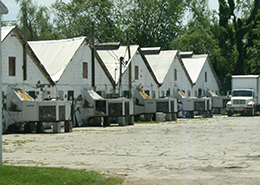Social Equity — Economy and Employment

Economy and employment are key issues to social equity because economic opportunities and access to well-paying jobs are effective means for disadvantaged populations to improve their quality of life. Economic opportunity and income levels impact not only the worker employed, but also their children, and other dependents such as elderly parents. Topics addressed in this section are: Median Income, Per Capita Income, Poverty, and Low-income Households.
Some useful websites that address this issue include:
- National Institutes of Health, Advancing Racial Equity
- Urban Institute, Racial Equity and Job Quality
- Duke University Samuel DuBois Cook Center on Social Equity, Employment
View mapping illustrating social equity and the economy in Chester County. This mapping addresses: per capita and median household income; unemployment and those with no health insurance; and low income and those below the poverty level.
Median Income and Per Capita Income
When conducting a social equity evaluation, information on median household income and per capita income can be useful in characterizing the economic conditions of individuals at the municipal level. These data can also be gathered at the neighborhood level, which can be derived from Block Group data generated by the US Census. These data can be evaluated along with data on race, ethnicity, and age distribution to get a snapshot of conditions facing disadvantaged communities.
Median Income and Per Capita Income
Source: US Census Bureau, 2021 American Community Survey 1-Year Estimates, S1901 (2020 data was not gathered due to COVID).
Some useful websites that address this issue include:
- Federal Reserve System: Wealth Inequality, and the Racial Wealth Gap
- Duke University Samuel DuBois Cook Center on Social Equity: What We Get Wrong About Closing the Racial Wealth Gap
- Harvard University: Harvard Gazette Racial wealth gap may be a key to other inequities
Poverty and Low-income Households
Much of the most valuable information that can be gathered for social equity relates to the economic conditions of families. The Census Bureau uses a set of income thresholds that vary by family size and composition to determine who is in poverty. If a family's total income is less than the family's threshold, then that family and every individual in it is considered in poverty. The term low-income usually refers to households whose earnings are 150% of the poverty level. However, the cost of living and housing in Chester County is high enough, that in our county, it is more practical to view low-income as 200% of the poverty level.
Chester County Persons Below the Poverty Level
Source: US Census Bureau, 2012 through 2021 American Community Survey 1-Year Estimates, S1701 (2020 data was not gathered due to COVID).
Some useful websites that address this issue include:
- US Department of the Treasury: Racial Inequality in the United States
- The Brookings Institute: Anti-poverty policies for children must level the playing field across both racial and economic lines
- American Bar Association: Combatting Poverty and Decriminalizing Homelessness Through a Race Equity Lens

